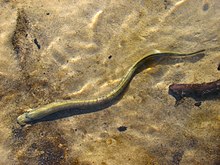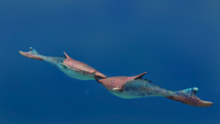Our website is made possible by displaying online advertisements to our visitors.
Please consider supporting us by disabling your ad blocker.
Agnatha
| Agnatha | |
|---|---|

| |
| A lamprey, a jawless fish belonging to Cyclostomi | |

| |
| Life reconstruction of extinct agnathan genus, Pteraspis (Pteraspidomorphi) | |
| Scientific classification | |
| Domain: | Eukaryota |
| Kingdom: | Animalia |
| Phylum: | Chordata |
| Subphylum: | Vertebrata |
| Infraphylum: | Agnatha Cope, 1889 |
| Groups included | |
| |
| Cladistically included but traditionally excluded taxa | |
| |
Agnatha (/ˈæɡnəθə, æɡˈneɪθə/;[3] from Ancient Greek ἀ- (a-) 'without' and γνάθος (gnáthos) 'jaws') is a paraphyletic infraphylum[4] of non-gnathostome vertebrates, or jawless fish, in the phylum Chordata, subphylum Vertebrata, consisting of both living (cyclostomes) and extinct (conodonts, anaspids, and ostracoderms, among others). Among recent animals, cyclostomes are sister to all vertebrates with jaws, known as gnathostomes.[5]
Molecular data, both from rRNA[6] and from mtDNA[7] as well as embryological data,[8] strongly supports the hypothesis that both groups of living agnathans, hagfishes and lampreys, are more closely related to each other than to jawed fish, forming the clade Cyclostomi.[9][6][7][10]
The oldest fossil agnathans appeared in the Cambrian. Living jawless fish comprise about 120 species in total. Hagfish are considered members of the subphylum Vertebrata, because they secondarily lost vertebrae; before this event was inferred from molecular[6][7][11] and developmental[12] data, the Craniata hypothesis was accepted (and is still sometimes used as a strictly morphological descriptor) to reference hagfish plus vertebrates.
- ^ Yang, Chuan; Li, Xian-Hua; Zhu, Maoyan; Condon, Daniel J.; Chen, Junyuan (2018). "Geochronological constraint on the Cambrian Chengjiang biota, South China" (PDF). Journal of the Geological Society. 175 (4): 659–666. Bibcode:2018JGSoc.175..659Y. doi:10.1144/jgs2017-103. ISSN 0016-7649. S2CID 135091168.
- ^ Märss, T.; Miller, C.G. (2004). "Thelodonts and distribution of associated conodonts from the Llandovery-lowermost Lochkovian of the Welsh Borderland". Palaeontology. 47 (5): 1211–1265. Bibcode:2004Palgy..47.1211M. doi:10.1111/j.0031-0239.2004.00409.x. [W. Kiessling/M. Krause/E. Ito]
- ^ Shorter Oxford English Dictionary
- ^ Ruggiero, Michael; Gordon, Dennis P.; Orrell, Thomas M.; Bailly, Nicolas (April 2015). "A Higher Level Classification of All Living Organisms". PLOS One. 10 (4): e0119248. Bibcode:2015PLoSO..1019248R. doi:10.1371/journal.pone.0119248. PMC 4418965. PMID 25923521.
- ^ Heimberg, Alysha M.; Cowper-Sal·lari, Richard; Sémon, Marie; Donoghue, Philip C.J.; Peterson, Kevin J. (2010-11-09). "microRNAs reveal the interrelationships of hagfish, lampreys, and gnathostomes and the nature of the ancestral vertebrate". Proceedings of the National Academy of Sciences. 107 (45): 19379–19383. doi:10.1073/pnas.1010350107. PMC 2984222. PMID 20959416.
- ^ a b c Mallatt, J.; Sullivan, J. (December 1998). "28S and 18S rDNA sequences support the monophyly of lampreys and hagfishes". Molecular Biology and Evolution. 15 (12): 1706–1718. doi:10.1093/oxfordjournals.molbev.a025897. PMID 9866205.
- ^ a b c Delarbre C, Gallut C, Barriel V, Janvier P, Gachelin G (February 2002). "Complete mitochondrial DNA of the hagfish, Eptatretus burgeri: The comparative analysis of mitochondrial DNA sequences strongly supports the cyclostome monophyly". Molecular Phylogenetics and Evolution. 22 (2): 184–92. Bibcode:2002MolPE..22..184D. doi:10.1006/mpev.2001.1045. PMID 11820840.
- ^ Oisi Y, Ota KG, Kuraku S, Fujimoto S, Kuratani S (January 2013). "Craniofacial development of hagfishes and the evolution of vertebrates". Nature. 493 (7431): 175–80. Bibcode:2013Natur.493..175O. doi:10.1038/nature11794. hdl:20.500.14094/D1005717. PMID 23254938. S2CID 4403344.
- ^ Janvier, P. (November 2010). "MicroRNAs revive old views about jawless vertebrate divergence and evolution". Proceedings of the National Academy of Sciences of the United States of America. 107 (45): 19137–19138. Bibcode:2010PNAS..10719137J. doi:10.1073/pnas.1014583107. PMC 2984170. PMID 21041649.
Although I was among the early supporters of vertebrate paraphyly, I am impressed by the evidence provided by Heimberg et al. and prepared to admit that cyclostomes are, in fact, monophyletic. The consequence is that they may tell us little, if anything, about the dawn of vertebrate evolution, except that the intuitions of 19th century zoologists were correct in assuming that these odd vertebrates (notably, hagfishes) are strongly degenerate and have lost many characters over time.
- ^ Stock, D.W.; Whitt, G.S. (August 1992). "Evidence from 18S ribosomal RNA sequences that lampreys and hagfishes form a natural group". Science. 257 (5071): 787–789. Bibcode:1992Sci...257..787S. doi:10.1126/science.1496398. PMID 1496398.
- ^ Stock, D.W.; Whitt, G.S. (August 1992). "Evidence from 18S ribosomal RNA sequences that lampreys and hagfishes form a natural group". Science. 257 (5071): 787–9. Bibcode:1992Sci...257..787S. doi:10.1126/science.1496398. PMID 1496398.
- ^ Ota KG, Fujimoto S, Oisi Y, Kuratani S (June 2011). "Identification of vertebra-like elements and their possible differentiation from sclerotomes in the hagfish". Nature Communications. 2 (6): 373. Bibcode:2011NatCo...2..373O. doi:10.1038/ncomms1355. PMC 3157150. PMID 21712821.
Previous Page Next Page


